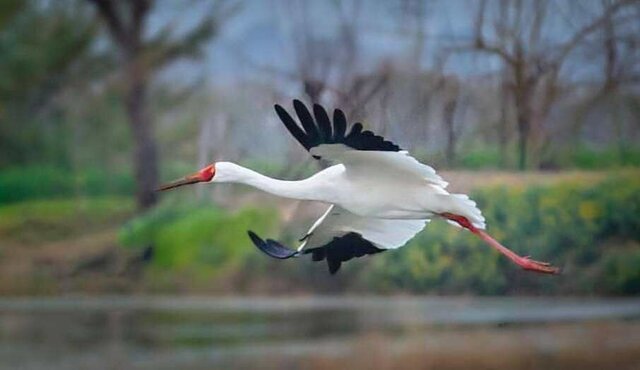Everyone talks about “hope” these days. A beautiful Siberian monopod arrived in Iran two days ago every year with a distance of 5700 km.
Journalists Plus: Central, the only survivor of the critically endangered Siberian crane who migrated alone for 15 years, has entered Lake Freydon once again and turned this bird into a hot topic in the media and cyberspace. But who is “Hope”?
Where did the singer come from?
“Omid” is a highly endangered bird of the Siberian “Kalangan” family. This bird has a special appearance that distinguishes it from other birds. This is a large bird with a height of about one and a half meters with a wingspan of more than two meters, a uniform white body, long red legs and a long black beak sitting on its red face.
The Siberian tern is divided into three main groups: eastern, western and central, with the central population endangered and the western population nearly extinct. Because from this generation only one bird remained named “Hope” and adding birds before the population did not work.
On the other hand, the only surviving group of Siberian terns is the eastern group, which breeds in eastern Siberia in summer and migrates to eastern China to spend the winter. There are more than 3,000 graves left among the members of this group and all of their winter habitat in Poyang Lake and its surroundings.

But the subject of this report is only “hope” that winter will bring him to the Miankala swamps. For years, Hope’s journey was unknown. Finally, satellite tracking showed that they entered Iran from the western Mazandaran Sea and spend the winter in the international wetlands of Verdankanar, Izbiran and Sarkhrud.
The migration route of “Hope” continues from Verdunkanar to the western coast of the Caspian Sea, and after passing through Gilan Province, the Republic of Azerbaijan, Dagestan and the Astrakhan region of Russia, turns to northern Kazakhstan and then continues. Ob River near the Arctic Ocean. .
“Hope” is a songbird and almost the entire migration route is isolated with its own song. His voice is calm, melodious and expressive, like a “crocodile crocodile”.
The story of “hope” and “desire”.
In the winter of 2006, three Siberian terns entered the swamp, but one of them was shot by poachers. A year later, in the winter of 2016, the two remaining Siberian terns, Omid and the other female, Arzu, returned to Verdun. In the same year Arzoo disappeared for unknown reasons. Now long after the death of Omid, Arzu, who was considered the last Western surviving Siberian tern, this monogamous tern has flown from the winter of 2016. Hundreds of kilometers for 12 consecutive years and winter migration.

Who cares about “Hope”?
In 1998, the Darna Mazandaran Environmental Conservation Society (MCCA) was formed in Iran with the support of Elaine Visalu Tavakoli (Finnish descent) and several Iranian environmentalists. In 2000, this small group of 200 bird hunters intended for MCCA to be a loan program with investments in local trusts.
This was an important initiative to protect the habitat of the Siberian tern in Iran. A project supported and funded by the Global Environment Facility and the United Nations Development Program (2001-2004) Small Grants Program. As a result of this project and the efforts of the MCCA, local fishermen became aware of the international importance of the Siberian tern and were recognized as the “keepers of the tern” by international organizations.
end of message /










